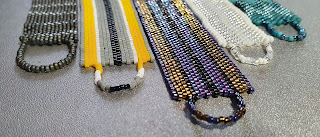This design reminds me of the Vegas Strip, not that I have ever been there, but it's so iconic. All those bright lights in the dark of the desert, so bright, it can be seen from space.
Things have changed though and my view is out of date. Lighting has changed.... The lights are LED now, not neon. Most of the big hotels are big on sustainability, using solar arrays to power the lights. Las Vegas is still the neon capital of the world though!
Las Vegas has it's very own Neon Museum. The Neon Boneyard is part of the museum but can only be accessed via a guided tour. It was setup to keep save the oldest neon signs of Vegas, to ensure icons were not lost. Over 150 signs have been preserved though the exhibit still includes broken glass. If you go at night, there is a show called Brilliant which uses projectors to show how some of the signs would have looked if they still worked. The Museum also works to maintain some of the neon signs that remain on the strip.
Neon lights work by trapping gases, not just neon, in a glass tube. High voltages are applied across the tube by attaching electrodes to each end. This electricity makes the gas light up because the electricity causes the gas to ionize, because it becomes charged and releases electrons. Neon gives an orange glow, while Hydrogen glows red, Helium yellow, Carbon Dioxide white and Mercury blue.
When a substance emits light it is known as fluorescent and this phenomenon was first exploited for magic tricks but fluorescent materials were developed for the military. Fluorescent printing inks became available in the 1950's and caused a stir with some feeling them vulgar. The 60s claimed these colours and psychedelia was born. Although the first highlighter pen became available in the early 60s, it was not until 1971 that Stabilo Boss released it's first highlighter and in 2011, 60 million are still produced each year.
My Dad was a printer and stationer. Whenever we visited the factory, looking in his stationery cupboard was my favourite thing, to see what new delights he had that I absolutely needed. I remember the yellow Stabilo Boss highlighters and the increasing number of colours. Fluorescent materials are hugely important in Personal Protective Equipment and I have certainly had fluorescent work clothing. Fitness clothing also draws on it to keep people safe as they exercise in the dark. I adore that new reflective white that has become common.
I wish Miyuki did beads that were really fluorescent but this must be a really different thing to achieve in a tiny glass bead. The neon and luminous colours are the closest we get and they really do add a bright pop!
Neon Strip is now available in my etsy shop and at GJ Beads.
If you want to look at my inspirations for this post, you can look at my pinterest board.

































































